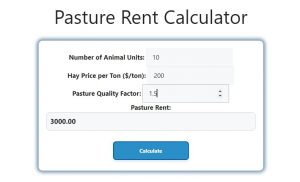About Pasture Rent Calculator (Formula)
The management of pastureland is a crucial aspect of livestock farming, influencing both the profitability and sustainability of agricultural operations. One essential tool for farmers and ranchers is the Pasture Rent Calculator, which helps determine the fair rental price for grazing land. This calculator considers various factors, including the number of animal units, hay prices per ton, and pasture quality, ensuring that both landowners and tenants arrive at a reasonable agreement for the use of pasture resources. Understanding how to accurately calculate pasture rent can lead to better financial planning and improved livestock management.
Formula
The formula for calculating pasture rent is:
Pasture Rent = Number of Animal Units * Hay Price per Ton * Pasture Quality Factor
Where:
- Pasture Rent = The total rental fee for the pasture.
- Number of Animal Units = The total number of livestock that will be grazing on the land.
- Hay Price per Ton = The market price of hay per ton, which serves as a basis for the rental value.
- Pasture Quality Factor = A multiplier that reflects the quality of the pasture, accounting for factors like soil health, forage availability, and overall productivity.
How to Use
Using the Pasture Rent Calculator involves a few straightforward steps:
- Gather Data:
- Determine the number of animal units that will be grazing on the pasture.
- Find the current market price of hay per ton.
- Assess the quality of the pasture and determine the appropriate pasture quality factor.
- Input Values into the Formula:
- Substitute the gathered data into the pasture rent formula.
- Calculate the Rent:
- Perform the calculation to find the total pasture rent.
- Review and Adjust:
- Consider any additional factors that may influence the rental rate, such as local market conditions or unique characteristics of the pastureland.
Example
To demonstrate how to use the Pasture Rent Calculator, let’s consider the following scenario:
Given:
- Number of Animal Units = 10
- Hay Price per Ton = $200
- Pasture Quality Factor = 1.5
Calculation:
- Substitute the values into the formula:
- Pasture Rent = 10 * $200 * 1.5
- Solve for Pasture Rent:
- Pasture Rent = $3,000
Thus, the total pasture rent for the grazing land is $3,000.

FAQs
- What is a pasture rent calculator?
A pasture rent calculator helps determine the fair rental price for grazing land based on several key factors. - Why is calculating pasture rent important?
It ensures that both landowners and tenants agree on a fair price, promoting transparency and good relationships. - What factors influence pasture rent?
Factors include the number of animal units, hay price per ton, and pasture quality. - How do I determine the number of animal units?
Animal units are typically based on the size and type of livestock, where one animal unit is equivalent to one mature cow. - What if the hay price fluctuates?
Regularly updating the hay price can help ensure that pasture rent remains fair and reflective of market conditions. - How is the pasture quality factor determined?
The pasture quality factor can be assessed based on soil health, forage availability, and the overall condition of the pasture. - Can the pasture rent calculator be used for different types of livestock?
Yes, it can be adapted to calculate rent for any type of grazing livestock. - What should I do if the pasture rent seems too high?
Consider negotiating with the landowner or reassessing the pasture quality and market conditions. - Are there industry standards for pasture rent?
Yes, local agricultural extensions or industry associations often publish guidelines or averages for pasture rent rates. - How often should I calculate pasture rent?
It’s advisable to calculate pasture rent annually or whenever market conditions significantly change. - What happens if the pasture quality declines?
A decline in pasture quality may warrant a decrease in the rental rate to reflect the reduced value. - Can I use the calculator for long-term rental agreements?
Yes, but it’s important to review the terms regularly to ensure they remain fair over time. - Is it possible to use the calculator for temporary grazing?
Yes, the calculator can also be useful for short-term grazing agreements. - What should I include in my rental agreement?
Include the rental rate, duration of the lease, responsibilities for land maintenance, and any contingencies for quality changes. - How can I improve pasture quality?
Implementing proper grazing management, soil health practices, and fertilization can enhance pasture quality. - What if I have multiple pastures?
Calculate the rent for each pasture individually based on their unique characteristics and conditions. - Are there tax implications for pasture rent?
Yes, both landowners and tenants should consult a tax professional to understand any tax obligations related to pasture rental income. - Can the calculator help with budgeting?
Absolutely, knowing the pasture rent can aid in financial planning and budgeting for livestock operations. - What if I want to rent out my pasture?
You can use the calculator to determine a fair rental price that reflects the pasture’s value. - Where can I find market price information for hay?
Local agricultural extensions, farmer cooperatives, or online commodity markets often provide current hay prices.
Conclusion
The Pasture Rent Calculator is an invaluable tool for farmers and ranchers aiming to establish fair rental agreements for grazing land. By considering key factors such as animal units, hay prices, and pasture quality, both landowners and tenants can arrive at a reasonable rental price that supports their agricultural goals. Regularly assessing pasture rent helps ensure financial stability, encourages responsible land management, and fosters positive relationships within the agricultural community.
